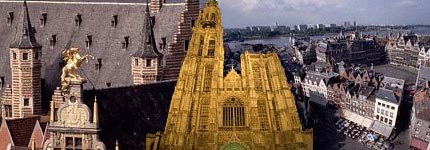|
Antwerp Community
Bars · Cafés
Dance Clubs
Erotic Shops
Hotels · Accommodation
Leather · Fetish
Organisations
Piercing · Tattoo
Restaurants
Saunas
Service
Shopping
Tourist Info
 Download Maps Download Maps
 Download Movies Download Movies


|


[english] [español] [français] [deutsch] [italiano]
Antwerp, city in northern Belgium,...
...administrative centre of the province of Antwerp and the main city of Flanders, on the Schelde River near the North Sea and Brussels. One of Europe's biggest ports, Antwerp is also the second largest city in Belgium.
Antwerp is connected to the industrial regions of south-east Belgium by the Albert Canal, which links it to Liège; the city also trades extensively with the Ruhr district in Germany. Grain and unrefined metals are major imports; exports include machinery, textiles, and other manufactured goods. Antwerp is especially well known for such industries as diamond cutting, shipbuilding, car assembly, and the manufacture of metal goods, electronic equipment, chemicals, and dyes.
Among the outstanding features of Antwerp is its system of boulevards, which replaced the walls that formerly encircled the city. The magnificent Gothic cathedral of Notre Dame (14th and 15th century), surmounted by a spire 121.9 m (400 ft) high, is the largest church in Belgium. The cathedral contains several paintings by Peter Paul Rubens, who spent most of his life in Antwerp. Other landmarks include the town hall and the Gothic church of St Paul, both completed in the 16th century, as well as the many medieval guild houses that still line the marketplace. The city has a museum of fine arts with paintings by several of the Flemish masters, and there are botanical and zoological gardens.
Antwerp became a port of commercial importance in the 15th century, when the first European stock exchange was founded in the city, and it rapidly became one of the foremost trading and manufacturing centres in Europe. During the early 16th century, the diamond industry was expanded by the arrival of skilled Jewish artisans expelled from Portugal. The city was also an active cultural and intellectual centre: the painter Anthony van Dyck was born there in 1599. Antwerp rapidly declined as a result of religious troubles after 1576, the year mutinous Spanish troops sacked the city. Another attack followed in 1584, and the city was forced to surrender to the Spanish in the following year. In 1648 Antwerp suffered a further blow under the provisions of the treaty known as the Peace of Westphalia, which closed the Schelde River to navigation; it was re-opened by the French in 1795.
The development of the modern city started in 1863 when the Belgians redeemed their navigation rights by making a cash payment to the Netherlands. Antwerp was occupied by the Germans during both world wars; in September 1944, it became an Allied supply base and was heavily bombed. Because the Schelde estuary was not cleared of German forces until March 1945, the use of Antwerp as an Allied supply port was limited. The city grew in importance after World War II and, in 1993, was nominated Cultural Capital of Europe.
Population: 447,632 (1999 estimate)
"Antwerp," Microsoft® Encarta® Online Encyclopedia 2002
http://encarta.msn.co.uk © 1997-2002 Microsoft Corporation. All rights reserved.
|
